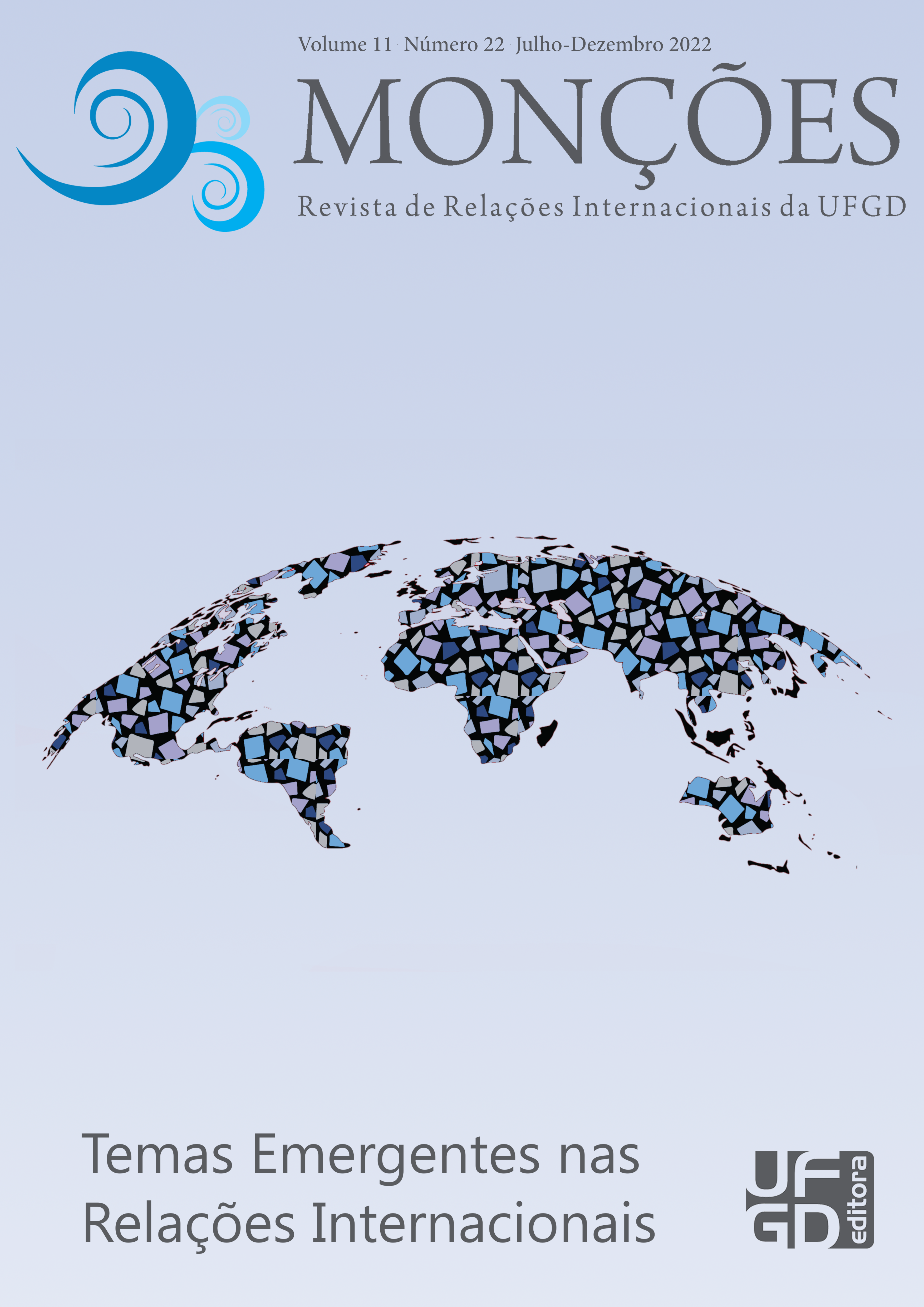Aesthetic turn and foreign policy
a Machadian reading of Brazil’s international identity
DOI:
https://doi.org/10.30612/rmufgd.v11i22.15070Keywords:
aesthetic turn, Brazilian foreign policy, Brazilian literatureAbstract
In this paper we intend to put Brazilian foreign policy into critical enquiry by means of the aesthetic turn in international relations. We dispute the traditional historiographical understanding regarding Brazil’s international identity. On the one hand, the narrative tells there was a well succeed performance at the Second Hague Peace Conference in 1907 during which Brazil supported the principle of sovereignty equality of states. On the other, it says its search for power status ended up in fiasco when Brazil withdrew from the
League of Nations in 1926. Rather, we aim at applying Machadian literature as an aesthetic device in order
to destabilize such interpretation and to think about Brazil’s international identity with ironic consciousness.
Through the allegory of Brás Cubas, we affirm that its unresolved identity brings about its frustrated quest for
international recognition.
Downloads
References
ASHLEY, Richard K.; WALKER, R. B. J. Conclusion: Reading Dissidence/Writing the Discipline: Crisis and the Question of Sovereignty in International Studies. International Studies Quarterly, Vol. 34, No. 3, Special Issue: Speaking the Language of Exile: Dissidence in International Studies. (Sep., 1990), pp. 367-416.
ASSIS, Machado de. Memórias póstumas de Brás Cubas. Fixação de texto, notas e posfácio de Antônio Sanseverino. Coordenação editorial, biografia do autor, cronologia e panorama do Rio de Janeiro por Luís Augusto Fischer. Porto Alegre: L&PM, 2013.
BARRETO, Lima. Os Bruzundangas (1922). Texto integral (Sátiras e Romances de Lima Barreto Livro 6). Arquivo Kindle.
BLEIKER, Roland. The Aesthetic Turn in International Political Theory. Millennium: Journal of International Studies, 2001, Vol. 30, No. 3, pp. 509-533.
_______. In Search of Thinking Space: Reflections on the Aesthetic Turn in International Political Theory. Forum: The Aesthetic Turn at 15. Millennium: Journal of International Studies, 2017, Vol. 45 (2), pp. 258-264.
CARDIM, Carlos Henrique. A raiz das coisas. Rui Barbosa: o Brasil e o mundo. Rio de Janeiro: Civilização Brasileira, 2007.
_______. Prefácio. In: COUTINHO, Maria do Carmo Strozzi (coord.). II Conferência da Paz, Haia, 1907: a correspondência telegráfica entre o Barão do Rio Branco e Rui Barbosa. Centro de História e Documentação Diplomática. Brasília: FUNAG, 2014, pp. 9-29.
CHEIBUB, Zairo Borges. Diplomacia e construção institucional: o Itamaraty em uma perspectiva histórica. Dados – Revista de Ciências Sociais. Rio de Janeiro, Vol. 28, n. 1, 1985, pp. 113-131.
DER DERIAN, James. Introducing Philosophical Traditions in International Relations. Millennium: Journal of International Studies, 1988, Vol. 17, No. 2, pp. 189-193.
DERRIDA, Jacques. A farmácia de Platão. Tradução de Rogério da Cosa. São Paulo: Iluminuras, 2005.
_______. Essa estranha instituição chamada literatura: uma entrevista com Jacques Derrida. Tradução de Marileide Dias Esqueda. Belo Horizonte: Editora UFMG, 2014.
GARCIA, Eugênio Vargas. A candidatura do Brasil a um assento permanente no Conselho da Liga das Nações. Rev. Bras. Polít. Int. 37 (1): 5-23 [1994].
_______. O Brasil e a Liga das Nações (1919-1926): vencer ou não perder. Porto Alegre: Editora da UFRGS; Brasília: FUNAG, 2000.
LAFER, Celso. A identidade internacional do Brasil e a política externa brasileira: passado, presente e futuro. São Paulo: Perspectiva, 2007.
_______. Relações Internacionais, política externa e diplomacia brasileira: pensamento e ação. Vol. 1. Brasília: FUNAG, 2018.
LAPID, Yosef. The Third Debate: On the Prospects of International Theory in a Post-Positivist Era. International Studies Quarterly, Vol. 33, No. 3 (Sept., 1989), pp. 235-254.
REGO, Enylton de Sá. O calundu e a panacéia: Machado de Assis, a sátira menipéia e a tradição luciânica. Rio de Janeiro: Forense Universitária, 1989.
RORTY, Richard. Contingency, irony, and solidarity. Cambridge: Cambridge University Press, 1989.
SANTOS, Luís Cláudio Villafañe Gomes. O Brasil entre a América e a Europa: o Império e o interamericanismo. São Paulo: Editora UNESP, 2004.
SANTOS, Norma Breda dos. Diplomacia e fiasco. Repensando a participação brasileira na Liga das Nações: elementos para uma nova interpretação. Rev. Bras. Polít. Int. 46 (1): 87-112 [2003].
_______. Grand Days: Noventa anos depois de o Brasil ter deixado Genebra, o que diz a historiografia sobre a participação brasileira na Liga das Nações (1920-1926)? Cadernos de Política Exterior, Ano II, Número 3, 1º Semestre 2016, pp. 195-220.
SCHWARZ, Roberto. Um mestre na periferia do capitalismo: Machado de Assis. 2ª Edição. São Paulo: Duas Cidades; Editora 34, 2012.
SOARES DE LIMA, Maria Regina. Aspiração internacional e política externa. Revista Brasileira de Comércio Exterior, no. 82, ano XIX, Janeiro/Março de 2005, pp. 4-19.
SPODE, Raphael. An Inquiry into the Moral and Religious Dimensions of International Politics: the Thought and Contribution of Rui Barbosa. Contexto Internacional, vol. 39 (1), Jan/Abr 2017, pp. 53-73.
SYLVESTER, Christine. Art, Abstraction, and International Relations. Millennium: Journal of International Studies, 2001, Vol. 30, No. 3, pp. 535-554.
WHITE, Hayden. Meta-História: A Imaginação Histórica do Século XIX. Tradução de José Laurênio de Melo. São Paulo: Editora da Universidade de São Paulo, 1992.
Downloads
Published
How to Cite
Issue
Section
License
Copyright (c) 2022 Luciano Muñoz

This work is licensed under a Creative Commons Attribution-NonCommercial-ShareAlike 3.0 Unported License.
- Os autores e autoras mantêm os direitos autorais e concedem à revista o direito de primeira publicação, com o trabalho simultaneamente licenciado sob a Creative Commons Atribuição-NãoComercial-CompartilhaIgual 3.0 Brasil. que permite o compartilhamento do trabalho com reconhecimento da autoria e publicação inicial nesta revista.
- Autores e autoras têm autorização para assumir contratos adicionais separadamente, para distribuição não-exclusiva da versão do trabalho publicada nesta revista (ex.: publicar em repositório institucional ou como capítulo de livro), com reconhecimento de autoria e publicação inicial nesta revista.
- Autores e autoras têm permissão e são estimulados a publicar e distribuir seu trabalho online (ex.: em repositórios institucionais ou na sua página pessoal) a qualquer ponto antes ou durante o processo editorial, já que isso pode gerar alterações produtivas, bem como aumentar o impacto e a citação do trabalho publicado, porém invariavelmente com o reconhecimento de autoria e publicação inicial nesta revista.

